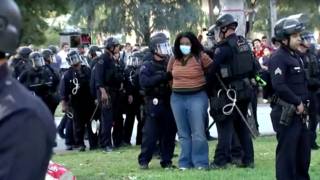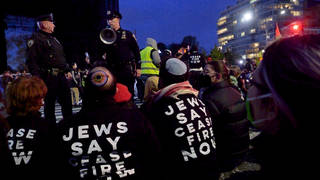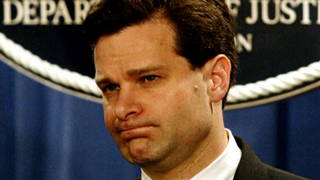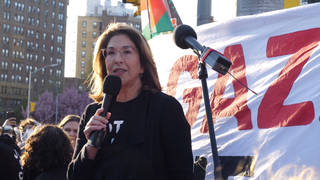
Related
Guests
- Vincent Warrenexecutive director of the Center for Constitutional Rights.
Today President Trump is flying to Philadelphia, where congressional Republicans are on retreat. He’s going in an effort to win more support for his political agenda. Over the past five days, he has signed a number of executive orders and presidential memorandums, on issues ranging from Obamacare to the Dakota Access pipeline to the U.S.-Mexico border wall, but many of his actions will require congressional support. We speak with Vincent Warren, the executive director of the Center for Constitutional Rights.
Transcript
AMY GOODMAN: Today, President Trump is flying to Philadelphia, where congressional Republicans are on retreat. He’s going in an effort to win more support for his political agenda. Over the past five days, he has signed a number of executive orders and presidential memorandums, but many of his actions will require congressional support. In his first day in office, Trump directed government agencies to freeze all pending regulations and to take steps to weaken the Affordable Care Act. Then, on Monday, Trump reinstated the controversial global gag rule, that bans U.S. funding for any international healthcare organizations that perform abortions, advocate for the legalization of abortion or even provide information about abortions. On that same day, Trump withdrew the United States from the Trans-Pacific Partnership. On Tuesday, he instituted a federal hiring freeze and issued presidential memorandums to revive the Dakota Access and Keystone XL pipelines. Then, on Wednesday, Trump signed a pair of wide-reaching executive orders dealing with expanding a wall along the U.S.-Mexico border, empowering state and local law enforcement to act as immigration officers, prohibiting federal funding of so-called sanctuary cities, and expanding the number of Border Patrol agents.
PRESIDENT DONALD TRUMP: The secretary of homeland security, working with myself and my staff, will begin immediate construction of a border wall.
AMY GOODMAN: And more executive orders are on the way. According to leaked documents, Trump may open the door for the CIA to reopen secret overseas black site prisons. And another executive order is in the works that would temporarily ban most refugees from entering the country and reportedly block visas from being issued to anyone from Syria, Iraq, Iran, Libya, Somalia, Sudan and Yemen.
To talk more about President Trump’s actions, we’re joined by two guests. Vincent Warren is the executive director of the Center for Constitutional Rights, and Faiza Patel is co-director of the Liberty and National Security program at the Brennan Center.
Vince, let’s begin with you. Before we get into the specifics of this slew of executive orders and presidential memoranda, can you talk about this—what has happened this week? And how binding are these moves that President Trump has made?
VINCENT WARREN: Well, this week has really been extraordinary, because we’ve seen that he’s just rolled out a series of actions and orders. Let me talk a little bit about executive orders. Executive orders are—can be done by the president, and they come from his Article II power. And so, he or she is allowed to move forward these orders that have the force of federal law. So some of the things that we’ve seen have the effect of federal law. Executive actions can be much broader and actually come from a subset of the power, and they could be things like memoranda and things like that. They have varying degrees of power.
As a general rule, they’re all challengeable, particularly if the orders or the actions are unconstitutional, they violate international human rights or they violate existing federal law. But those are actions that the president can take. And just as an example, things like interning the Japanese were presidential orders, things like that. So, there’s an opportunity here to not only see what he’s putting forward, but a lot of us who are in the social justice field are looking for opportunities and ways to be able to challenge these executive orders and actions. But, of course, as we’re going to be talking about later, some of them have not come out yet. We have to see what these things say, what they actually mean, and then we have to think about ways to challenge them.
AMY GOODMAN: I mean, and the difference between a presidential memorandum, as was the case with the reviving of the Keystone XL pipeline and moving forward with the Dakota Access pipeline, and an executive order?
VINCENT WARREN: Yes, there is. And, you know, it’s—you could think about it as a game of presidential ping-pong. So, President Obama, for example, issued executive actions around DACA, and then President Trump is going to—you know, theoretically can come in and redo that. And similarly, with respect to the decision of President Obama not to move forward with the Keystone pipeline, President Trump comes in and issues a presidential memorandum saying move forward on that. These are challengeable issues. But we have to remember that they’re not the same as federal law and laws that pass by Congress. Laws that get passed by Congress are harder to enact, because it requires congressional consent in a vote, and they’re also harder to withdraw, because that also requires congressional consent. So the idea here is that presidents will move forward to move forward their agenda. In executive orders, it’s largely taking executive agencies and ordering them to do something. So, for example, ordering them to build a wall is a good example of an executive order, because it’s ordering the agencies under the president’s power to be able to do something.
AMY GOODMAN: So you had, for example, one of the first executive orders that President Obama issued in 2009 was closing Guantánamo in a year. So, it’s 2017, he served for eight years, and that never happened.
VINCENT WARREN: That never happened. And what we’re likely to see coming down the road, and at least if the leaked documents are correct, that President Trump is going to be issuing an order that says Guantánamo is to remain open and, in fact, that new prisoners that are captured can and should be brought to Guantánamo. So President Trump is essentially using his executive power to reverse the course of many of the things that President Obama did, including things like a permanent ban on torture with respect to the CIA and the Army and U.S. government officials.












Media Options